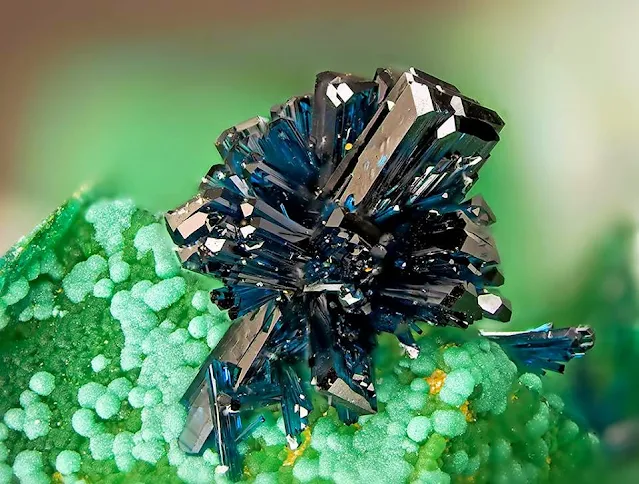Clinoclase Crystals
Clinoclase is a rare secondary copper mineral and forms acicular
crystals in the fractured weathered zone above copper sulfide deposits.
It occurs in vitreous, translucent dark blue to dark greenish blue
colored crystals and botryoidal masses. The crystal system is monoclinic 2/m. It has a hardness of 2.5 - 3 and a relative density of 4.3. Associated minerals include malachite, olivenite, quartz, limonite, adamite, azurite, and brochantite among others.
Clinoclase : Cu3(AsO4)(OH)3
Crystal System: Monoclinic
Color: Dark greenish blue to greenish black; in transmitted light, blue-green.
Hardness: 2.5 - 3.0
Tenacity: brittle
Occurrence: A rare secondary mineral in the oxidized zone of some arsenic-rich hydrothermal
base-metal deposits.
Association: Olivenite, cornwallite, cornubite, conichalcite.
The type locality for clinoclase is the Wheal Gorland mine at St Day, Cornwall in the United Kingdom.
Clinoclase was discovered in 1830 in the county of Cornwall in England.
Abichite is another name for clinoclase.
The specimen in the photo is From: Clara Mine, Rankach valley, Oberwolfach, Wolfach, Black Forest, Baden-Württemberg, Germany
Clinoclase : Cu3(AsO4)(OH)3
Crystal System: Monoclinic
Color: Dark greenish blue to greenish black; in transmitted light, blue-green.
Hardness: 2.5 - 3.0
Tenacity: brittle
Occurrence: A rare secondary mineral in the oxidized zone of some arsenic-rich hydrothermal
base-metal deposits.
Association: Olivenite, cornwallite, cornubite, conichalcite.
The type locality for clinoclase is the Wheal Gorland mine at St Day, Cornwall in the United Kingdom.
Clinoclase was discovered in 1830 in the county of Cornwall in England.
Abichite is another name for clinoclase.
The specimen in the photo is From: Clara Mine, Rankach valley, Oberwolfach, Wolfach, Black Forest, Baden-Württemberg, Germany









